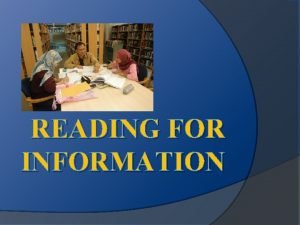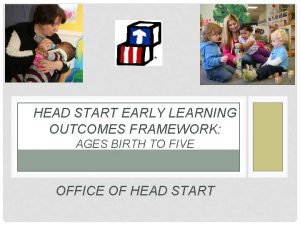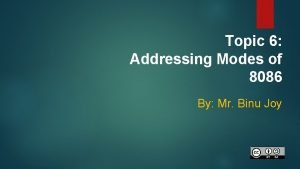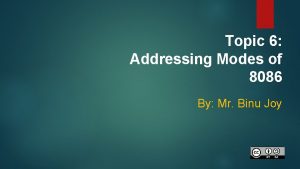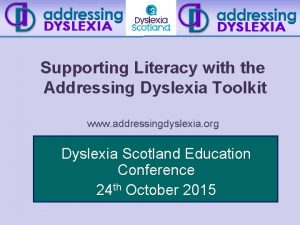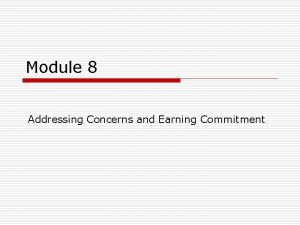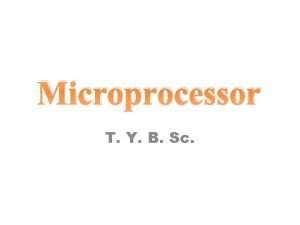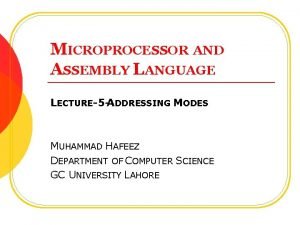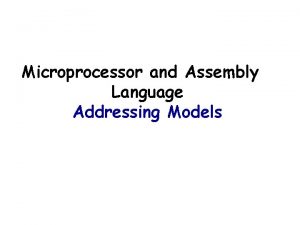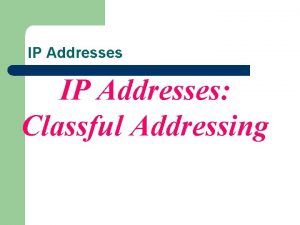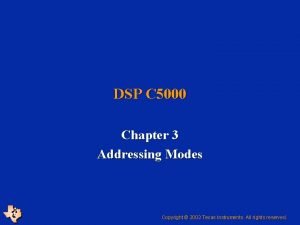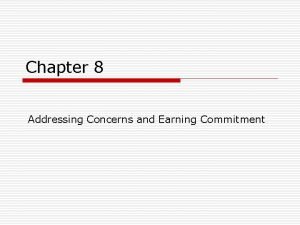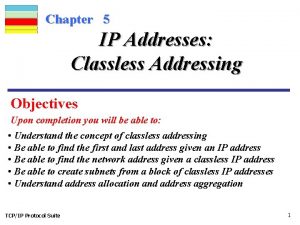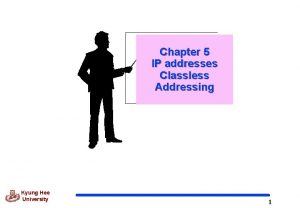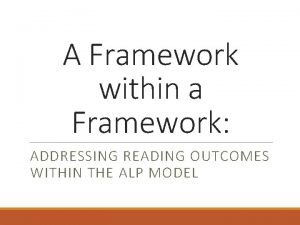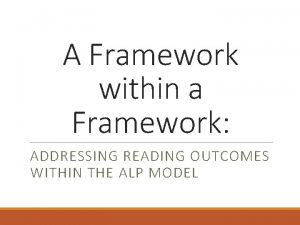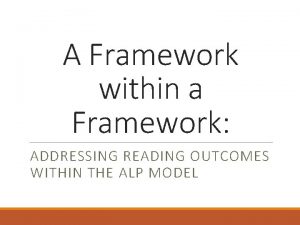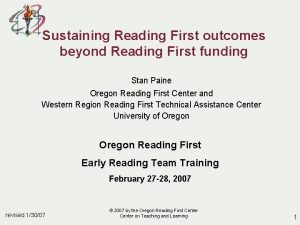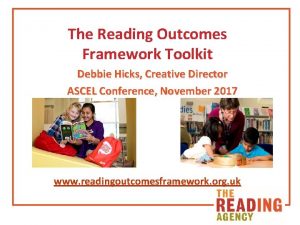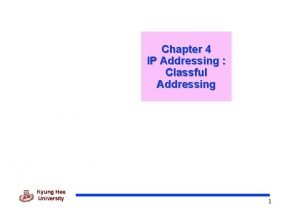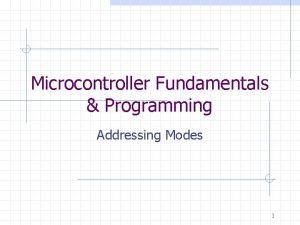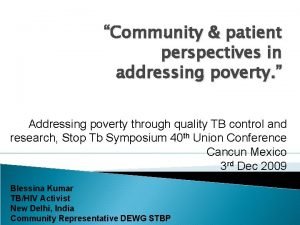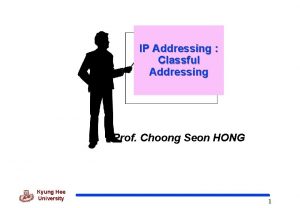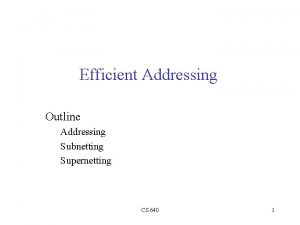A Framework within a Framework ADDRESSING READING OUTCOMES































- Slides: 31

A Framework within a Framework: ADDRESSING READING OUTCOMES WITHIN THE ALP MODEL

Framework within a Framework: Addressing Reading Outcomes within the ALP model Francie Woodford, Ph. D. Community College of Philadelphia fwoodford@ccp. edu ALP Pilot Spring 2018: ESL and Developmental

Reading is the Key Xijun Huang Apr 17, 2018 Apr 17 at 11: 47 pm Hi Siarhei Could you tell me how do you know that much about paraphrase, because I still confusing about it?

Siarhei Starasvetski Apr 21, 2018 Apr 21 at 2: 33 pm Thank you Xijun. Alright, let me tell you my little secret: I read a lot. First of all, reading helps me to expand vocabulary and secondly, unconsciously I memorize how other writers structure their sentences. As a result of this practice, I developed a sense what is right and what is not. If you are asking me how I do that, my answer is I don't know. I use my inner feelings which I believe were developed through the reading. Moreover, I have not attended any schools in the US and have never written in English more than one sentence in my life, until this semester in the school of course. Reading is the key to your question.

Pre-College Reading Outcomes: Literal vs. Implied Meaning Comprehension Summary Paraphrase Annotation Vocabulary

Reassessment of Teaching and Learning • Rethink pre-college reading (Hayes et al. , 2018) • Revise teaching and learning based on cognitive science research (Brown et al. , 2014) • Revive Bloom’s Taxonomy (Bloom, 1956)

Rethinking Developmental Reading (adapted from Hayes et al. , 2018) 1. Skill-Embedded Curriculum: backward design and authentic academic (whole) texts, mini-lessons as needed or requested, segmented (engaging) questions with Bloom’s taxonomy and critical thinking as hierarchical goals 2. Thinking-based Pedagogy: Thematic approach with active learning techniques, growth mindset (lose assumptions about order of learning), “triage” (aka “just in time remediation”) 3. Growth-Centered Assessment: multiple low-risk writing opportunities before larger tests and essays (holistic, progressive approach to grading), reflective and metacognitive, (self, peer and teacher) meta-cognitive reflection and evaluation

Cognitive Research (Brown et al. , 2014) Use Testing as a Tool for Learning (aka formative vs. summative testing) “Testing not only measures knowledge but changes it…. this is one of the most powerful learning tools we have. ” –Roediger

Dynamic Testing (Brown et al. , 2014, p. 152) Step 1: A test of some kind—perhaps an experience or a paper exam—shows me where I come up short in knowledge or a skill. Step 2: I dedicate myself to becoming more competent, using reflection, practice, spacing, and other techniques of effective learning (where, when and how I study for deliberate practice). Step 3: I test myself again, paying attention to what works better now but also, and especially, to where I still need more work.


Weekly Schedule for a class meeting twice a week Day 1 Day 2 Due: Annotation of longer reading Due: Shorter reading, on-line quiz (5 T/F or (content / page-turner) and Video multiple choice questions), blogging to Day 1 video post, writing (peer review/essay post paragraph 7 -10 sentences drafts) In Class: Discuss, debate, present In Class: Go over T/F quiz, group work / peer reading before short-essay test review or workshop on drafts Short-essay tests: graded, Return: short-essay tests from Day 1 to be rewritten and posted on Day 1 rewritten and posted before next class every week

Grade Breakdown FRESHMAN COMPOSITION (101) Interactive Learning: in class and on line (discussions, blogging and surveys) 10 points (Extra Credit possible) 10 online quizzes 10 points 10 in-class short-essay tests 10 points 4 Essays: 55 points: Essay 1: Informative Essay 2 Midterm: Analysis / Argument Essay 3: Research Essay 4 Final: Persuasive 10 points 15 points Interactive Learning: discussions, blogging and surveys (activities both in class and online) 50 points Rewrite 101 short-essay tests (Posted on Canvas) 50 points 20 points 10 points 3 Peer review letters (5 points each) 15 points Portfolio Cover Letter Extra Credit Total Points PRE-COLLEGE ENGLISH (098) 100 points Total points 100 points

Freshman Composition (101) Interactive Learning: in class and on line (discussions, blogging and surveys) 10 points (Extra Credit possible) 10 online quizzes (5 T/F questions) 10 points 10 in-class short-essay tests 10 points 4 Essays: Essay 1: Informative Essay 2 Midterm: Analysis / Argument Essay 3: Research Essay 4: Persuasive (In-class writing) 3 Peer review letters 55 points: 10 points 15 points 20 points 15 points Portfolio Cover Letter Total Points Extra Credit 100 points

Pre-College English (098) Interactive Learning: discussions, blogging, and surveys (activities both in class and online) 50 points Rewrite 101 short-essay tests 50 points (Posted on Canvas) Total points 100 points

References Bloom’s Taxonomy (1956): Image retrieved from https: //www. google. com/search? q=bloom%27 s+taxonomy+image Brown, P. C. , Roediger III, H. L. , & Mc. Daniel, M. A. (2014). Make it stick: The science of successful learning. Cambridge: The Belknap Press of Harvard University Press. Hayes, S. M. , Lassen, L. , Parker, D. , & Parker, N. (2018). Amping Up Developmental Reading, Writing, and Critical Thinking for Academic Success [Power. Point slides]. CADE 2018 website.

Appendix SLOS AND SAMPLE ASSIGNMENTS

Reading SLOs ESL AND DEVELOPMENTAL ENGLISH

SLOs: Comprehension ESL DEVELOPMENTAL ENGLISH Answer comprehension questions eliciting both literal and implied meaning of the author. Draw conclusions about the meaning(s) of a text. Discuss interpretative issues.

Directions: Comprehension Questions Choose ONE questions to answer (or both for extra credit). Do not copy from the text. Your answer must be in your own words. Give your interpretation, not your opinion. Write a complete paragraph (7 -10 sentences) following academic format. First, answer the question directly in the first sentence, introducing the title and the author; then, explain your answer based on the context of the reading, and conclude by returning to your answer and connecting it to the support you provided. Finally, remember to re-read your answer carefully to check your grammar, spelling and punctuation.

Sample Questions: Comprehension / Interpretation / Inference Explain the meaning of the title “Lost in the Middle” based on your understanding of the reading. In “Marita’s Bargain, ” what is Malcolm Gladwell suggesting that we do to improve education in the U. S. ?

SLOs: Summary ESL Write a coherent summary with minimal grammatical errors. DEVELOPMENTAL ENGLISH Summarize a variety of texts to develop and demonstrate comprehension.

Sample Directions: Interpretive Summary Interpretive summaries test your ability to interpret the main point of the author. A summary includes an explanation of the author’s main points, not your opinion. An interpretive summary is short, so do not include details or examples. Write the summary as one paragraph (7 -10 sentences). Choose ONE question to answer (or both for extra credit). Do not copy from the text. It’s VERY important that you use the context of the reading. Also, if you copy too much from the reading or the dictionary, your answer will not receive any credit. Explain your answers in your own words. Always remember to re-reading checking your grammar, spelling and punctuation.

Sample Question / Outline 1) Introductory Sentence(s): In chapter three of Outliers, “The Trouble with Geniuses, Part 2, ” Malcolm Gladwell … (Choose a verb from Graff and Birkenstein (39 -40) to complete the first sentence with your interpretation of the main point. ) 2) Body Sentences: Explain your interpretation of the main point without going into detail or examples. 3) Concluding Sentence(s): Synthesize your interpretation of the main point with your explanation in the body.

SLOs: Paraphrase in Context ESL Paraphrase ideas in reading texts without altering meaning. Demonstrate ability to use vocabulary from the readings in original sentences. DEVELOPMENTAL ENGLISH Paraphrase a short passage to develop and demonstrate comprehension.

Sample Directions: Paraphrase in Context A paraphrase is a translation in your own words using third person. Introduce your paraphrase by introducing the author and the context. “Context” is another way of saying the “situation” or the paragraph of the reading. Ask yourself questions (e. g. , who, what, where, why and how) to help guide you. Remember not to copy from the reading or the dictionary; otherwise, your answer will not receive any credit. Always remember to re-read your answers to check for grammar, spelling and punctuation.

Sample Questions: Paraphrase in Context Introduce your paraphrase following in the models in Graff and Birkenstein (47): 1) “We pretend that success is exclusively a matter of individual merit” (Gladwell, Outliers, 67). 2) “…there is a reproducible correlation between the time required to pronounce numbers in a given language and the memory span of its speakers” (Gladwell, Outliers, 228).

SLOs: Annotation ESL Annotate a given text to summarize main ideas and supporting details and express responses. DEVELOPMENTAL ENGLISH Employ active reading strategies to demonstrate understanding of a variety of texts, including differentiating between main ideas and supporting details.

Annotation Directions Annotation means taking notes on the page (in pencil so that you can erase it). If you highlight or underline main points, you write a note in the margins to remind yourself why you think this point is important. As you read, ask yourself, “What did I learn? ” and “How can I apply this knowledge to what I already know? ” Think of the words on the page as the author talking to you and your comments in the margin represent your response. Symbols (e. g. , ! @ # $ % ^ & * ( ) [ ] { }) can be used to indicate your responses. Also, circling words (e. g. , names, dates, places and unknown vocabulary) will also help to highlight context. Write comments to help you remember the reading.

SLOs: Vocabulary ESL Discern word meaning via dictionary use, context clues and identification of word parts. DEVELOPMENTAL ENGLISH Discern word meaning, using vocabulary development strategies, to increase understanding of a text.

Sample Directions: Vocabulary in Context First, if necessary, choose the correct meaning from the dictionary for the context in the reading. Second, notice how the words are used in the sentence: What part of speech are they (e. g. , noun, verb, adjective)? If you don’t know, look in the dictionary. Third, introduce your paraphrase by identifying the context, the referent and the person who is saying the quote. Use your own words in third person. In other words, what does this word mean in this sentence? Finally, paraphrase the sentence focusing on the meaning of this word in the context. Finally, check your grammar, spelling and punctuation for full credit.

Sample Questions: Vocabulary in Context In chapter one of Outliers, Gladwell describes the notions of (individual) meritocracy (16 -17) vs. “accumulative advantage” (30). Explain the literal meaning of these words and Gladwell’s main point in this chapter. Anomalies (Gladwell, Outliers, 197): “Mitigation explains one of the great anomalies of plane crashes. ” Indelible (Gladwell, Outliers, 219): “But he didn’t assume that legacies are an indelible part of who we are. ”
 Flat addressing vs hierarchical addressing
Flat addressing vs hierarchical addressing While reading activities
While reading activities Reading outcomes
Reading outcomes Learning outcomes examples
Learning outcomes examples Headstart early learning outcomes framework
Headstart early learning outcomes framework Learning outcomes framework
Learning outcomes framework St. louis
St. louis Aims and objectives of teaching
Aims and objectives of teaching Stages of reading skills
Stages of reading skills Edb net
Edb net Involves scrutinizing any information that you read or hear
Involves scrutinizing any information that you read or hear Real definition of extensive reading
Real definition of extensive reading Intensive reading and extensive reading
Intensive reading and extensive reading Intensive reading definition
Intensive reading definition Intrasegment direct addressing mode
Intrasegment direct addressing mode Addressing modes of 8086 microprocessor
Addressing modes of 8086 microprocessor Addressing dyslexia toolkit
Addressing dyslexia toolkit Addressing mode in computer architecture
Addressing mode in computer architecture Addressing concerns and earning commitment
Addressing concerns and earning commitment Immediate addressing mode in assembly language
Immediate addressing mode in assembly language Addressing mode in assembly language
Addressing mode in assembly language Protected mode memory addressing
Protected mode memory addressing Classful addressing
Classful addressing Classful addressing example
Classful addressing example _tmain
_tmain Bit reversed addressing mode in dsp
Bit reversed addressing mode in dsp 8 great ideas in computer architecture
8 great ideas in computer architecture Sic/xe nixbpe
Sic/xe nixbpe Difference between classful and classless addressing
Difference between classful and classless addressing Earning commitment
Earning commitment Difference between classful and classless addressing
Difference between classful and classless addressing Classless addressing example
Classless addressing example


